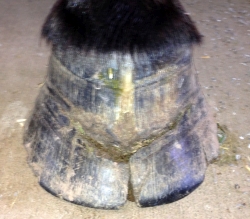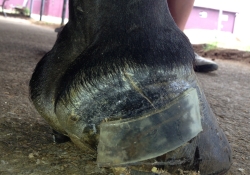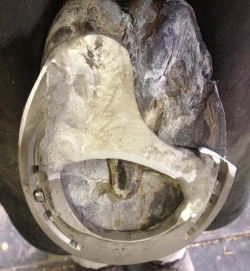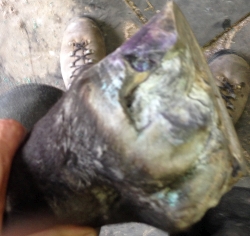Loss of hoof wall could be the result of several factors including injury, disease, and infection. Often a horse can lose what appears to be massive amounts of wall, but still be sound and moving well. Other times the smallest crack can result in lameness.
The important factors are the location and cause of the damage. Fig. 1 shows the hoof of a broodmare that at the time of this photo was sound, and still is. Several months ago, she had a terrible abscess in the toe of this hoof that tracked all the way up to the coronet band and exited there, causing her to be lame. The resulting path of the abscess left a separation between the sensitive structure within the hoof and the harder hoof wall.
While certainly not ideal, these separations are normally shallow and quite manageable after the infection is gone. Notice the upper third of the hoof wall is intact and shows healthy growth. This is a good indication that she is well on her way to a normal hoof.
An abscess like this has two dangerous times: When the infection is at its peak and about to exit the hoof--the horse is normally very lame at this point--and when the affected hoof wall grows down close to the ground surface. If at any time this mare gets lame during this phase, we will shoe her. So far she has been sound since her abscess and barring any new event, should regrow healthy hoof wall without further trouble. Keep in mind she is already past her foaling for this year.


In racehorses, the latter concern is often as serious as the former. We often put bar shoes on a horse with a damaged hoof wall that has grown down to the ground surface border, even though the cause has long been resolved.
Fig. 2 shows a faint crack that goes all the way into the hairline. This is a racehorse that was bleeding from the crack when training. No hoof wall is missing, but the horse is lame. Someone attempted to help by gluing a piece of plastic over it, which offered no benefit. This horse had to be removed from training briefly so the crack could be debrided, dried out, and patched more substantially.
Fig. 3 shows the hoof of a horse that had deep bruising under the medial (inside) heel. The bruise became infected, crippling the horse. After removing all hoof wall over the captured infection (Fig. 4), the horse became much sounder. While Fig. 4 isn’t in great focus (sorry), what is highly visible is that at least a half-inch of healthy hoof exists between the debrided area and the hairline, which is a very good omen. This horse actually won an Indiana Sire Stakes race shortly after the photo was taken. Even though we debrided a massive amount of hoof wall from that medial heel, the horse improved quickly.
The key with racehorses having hoof wall trauma is to act before the trouble migrates into the
hairline. The key to turnouts and broodmares is to know what caused the hoof damage as opposed to nearly always knowing what happened with racehorses. I recently saw a lame yearling with a large piece of hoof broken away. The yearling was lame from an abscess on the other side of that same hoof. The broken hoof was not the source of the lameness.


Often people see a damaged hoof and logically assume that is lameness. The Standardbred horse is one tough critter. Andover Hall is a great example. Having made a break and cut a hoof badly in the first heat of the World Trotting Derby, he then set two world records afterward—the same day. I still cannot get people outside of the Standardbred industry to believe that story.
So, while a damaged hoof is definitely cause for concern and should be looked into, it is not necessarily panic time. Outside of catastrophic injury, many of the most serious hoof problems start internally, not externally.
In many cases it is the healthy-looking hoof that needs the attention. It is not always the eyesore that makes the horse sore.
Veteran Standardbred farrier Steve Stanley of Lexington, Ky., authors a monthly column for Hoof Beats, the official harness racing publication of the U.S. Trotting Association. The American Farriers Journal Editorial Advisory Board member offers plenty of practical advice that will be of special interest regardless of the type of horses that you work with. Click here to read more from Steve Stanley's Hoof Beats series.








Post a comment
Report Abusive Comment